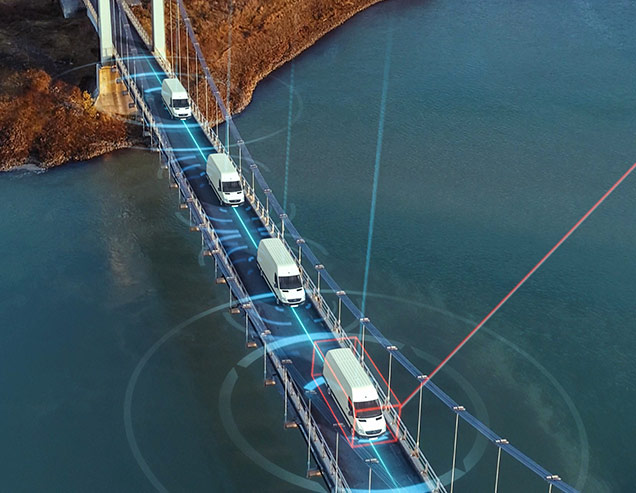
| READ TIME: 26 MINS INDUSTRY: ALL AUDIENCE: SHIPPING EXECUTIVES |
As technology progresses, automation has become a source of excitement and innovation. Self-driving cars are now moving within reach, and developers are preparing these vehicles for both passenger and commercial use. Autonomous semi-trucks will be some of the first to hit the roads and are anticipated to change the landscape of the transportation industry in various ways.
Autonomous trucks are equipped with a variety of sensors and cameras to help gather information about the truck’s surroundings. A computer then interprets that data and makes decisions about speed, lane changes, and navigation to deliver its load successfully. Like self-driving passenger vehicles, autonomous trucks rely on code that combines artificial intelligence with data gathered from the vehicle’s surroundings, maps, and predictive algorithms to function as a human driver would. Due to the complexity of the software required to make self-driving trucks a reality, developers are constantly working on new ways to refine the code and AI that powers these trucks.




Although the driving technology required to power autonomous trucks is advancing quickly, it will be years before fully autonomous fleets hit the road. There are several levels to what is considered an autonomous vehicle and four main phases to the actual implementation of driverless trucks.
The Society of Automotive Engineers has standardized the taxonomy and definitions related to automated vehicles and created six levels to classify them. These are referred to as the SAE Levels of Driving Automation. The levels begin at 0 with features like automatic emergency braking or a blindspot warning and range to level five, where full automation can function in all conditions without a driver to monitor the driving system. Level three is where features that do not require the person in the driver’s seat to take action begin. At this level, the driver is only required to take action when the feature requests; however, the features can only drive the vehicle under limited conditions.
As more advanced level four and five trucks roll out, they will likely do so in four phases. The phases involve trucks platooning or following close behind each other in a line.

In the first phase, there is a driver in each truck

In the second phase, there is only a driver in the lead truck.

The third phase only utilizes a human driver for picking up and dropping off a load.

The final phase does not require human drivers at all.
It is expected that in 2027 autonomous trucks could be able to enter phase two, while other estimates cite the end of the 2030s as when fully autonomous trucks with no driver will be ready for commercial use.


There are several challenges to getting autonomous trucks ready for the road. Current technological barriers include how to get these vehicles on and off highways independently and how to guide them at ports and when navigating situations that are more difficult to predict. Sudden changes in weather and unexpected road conditions can create a hazardous situation for an autonomous truck. As the technology powering these vehicles progresses, solutions to these problems will emerge. However, for now, safety drivers are necessary in many cases to ensure a smooth operating experience.
In addition to barriers in current technology, regulations for autonomous vehicles vary from state to state. Some developers call for a better understanding of the expectations for self-driving commercial vehicles. In the United States, as of March 2023, more than half of the states had legislation allowing autonomous vehicles, and six states permitted testing autonomous vehicles through an executive order. However, not all states allow these vehicles, and some have taken steps to further regulate driverless trucks.




Views on automated trucks vary dramatically publicly and within the transportation industry. As a result, the rules governing the testing and implementation of these vehicles are different across the country and open to continuous change.
In Michigan, a driver is not required but must be licensed to drive if one is in the cab. Florida, Georgia, Nevada, North Carolina, North Dakota, Utah, and West Virginia, do not require a driver, and unlicensed individuals may fulfill the role of a safety driver as long as the vehicle in question is at least an SAE level 4 or 5.
In other states, a licensed safety driver must be behind the wheel to monitor the performance of self-driving systems. Arizona, Kansas, and Nebraska all require a licensed driver, while New Hampshire only requires this while the vehicle is being tested. Other states like Arkansas, Alabama, and Louisiana only allow commercial autonomous vehicles to be on the road.


Although we are still in the early stages of autonomous trucking, there is much to look forward to as this technology develops. According to Chad Thomas, England Logistics’ Senior Director of Logistics Services,
“There is a lot of unknown, but the benefits to overall supply chains are going to be significant.”
Some of the advantages of implementing these trucks are the impact on the cost of transporting a load. Driverless trucks can go for longer hours than human drivers and avoid safety concerns from driver fatigue. A test drive of a self-driving truck delivering a load in 2022 completed a 6,300-mile journey in only five days. The same trip would take a human driver ten days under Hours of Service rules. In addition, there is evidence that autonomous trucks could optimize throttle and brake controls to save fuel, significantly lowering the cost of transporting a load and increasing efficiency.
With the implementation of new technology, there will be disruptions. One of the significant changes that are tensely anticipated will be driver employment. Although it will take many years for the full impact of this disruption to be felt, there will be a decrease in the need for long-haul truck drivers once autonomous vehicles are widely adopted. This will happen gradually as the technology surrounding autonomous vehicles progresses and will take several decades to fully take place across the industry. There will always be a need for drivers, even if that role looks different in the future, and some suggest that autonomous trucks will create new jobs. In addition to safety drivers, there will be a need for remote driving assistance, new maintenance practices, and operators needed to guide trucks through the loading and unloading process and with customer service.

As these changes hit the market, finding the right time to adopt this technology is essential. Thomas explains,
“As an intermediary, England Logistics is in a great position to watch this unfold and find the right point of participation that delivers the highest degree of value for our shippers and client community.”
The participation of third-party logistics companies can help to progress the adoption of driverless vehicles by helping connect shippers to autonomous trucking options. Thomas adds that
“third-party logistics companies are able to assemble and densify a freight network that autonomous vehicles can participate in. We’re the perfect partner for that type of activity because the evolution flows through us.”
As the progression of autonomous trucking unfolds, there is a lot to be excited about. This technology has the potential to change the landscape of the trucking industry and make the supply chain move more efficiently. Although it will be many years before the full effect of autonomous vehicles hits the market, building the relationships needed to take advantage of this new shipping method is something to start considering now.


The England Logistics Full Truckload division offers services for companies of all sizes. Dedicated team members are available day and night to offer solutions and assistance with all logistical needs. Regardless of the transportation mode, our market and seasonal specialists provide flexible shipping solutions and are committed to helping every step of the way.